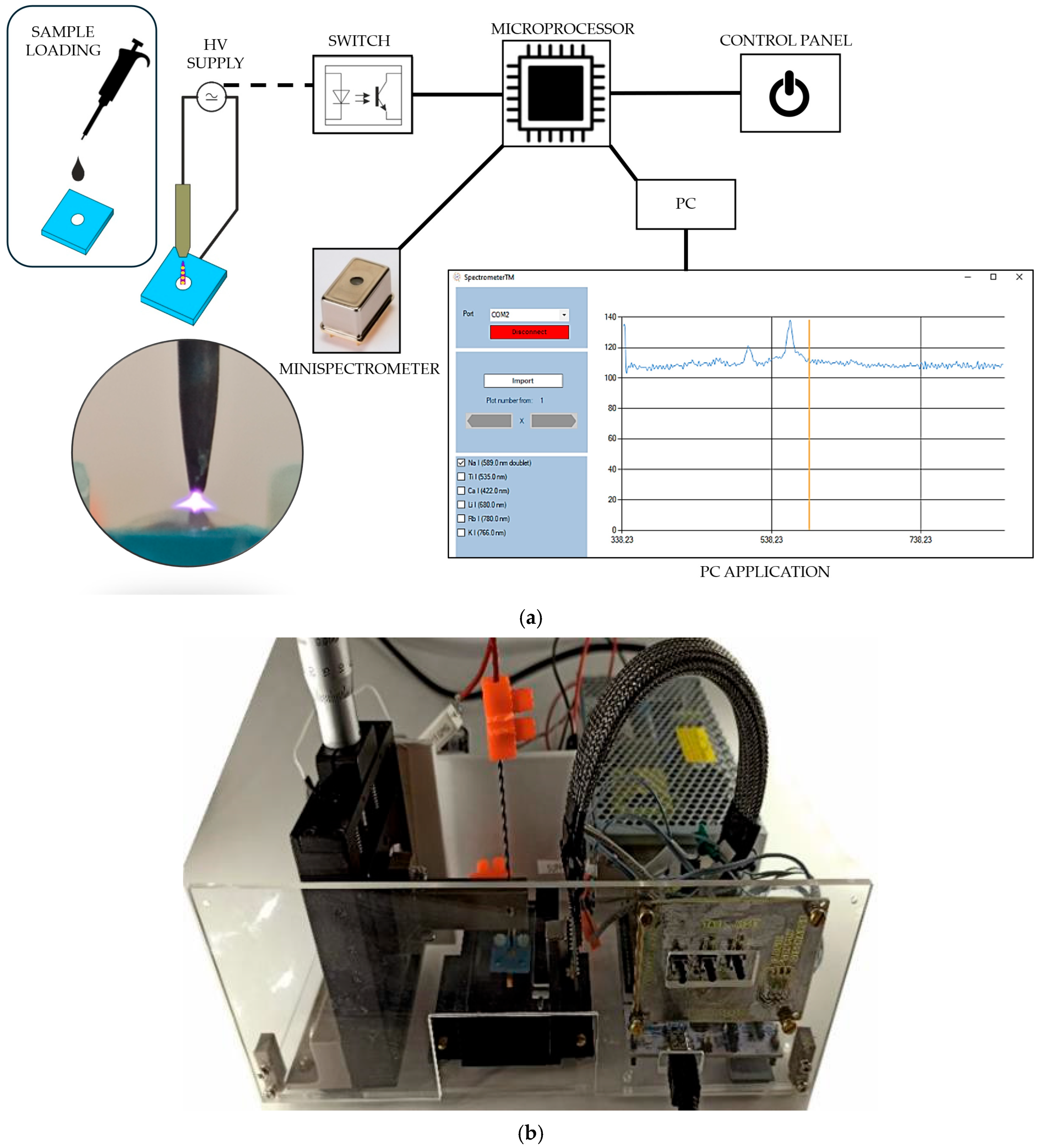Optical Detection System of Heavy Metals Based on Microplasma Excitation †
Abstract
:1. Introduction
2. Materials and Methods
3. Discussion
Author Contributions
Funding
Institutional Review Board Statement
Informed Consent Statement
Data Availability Statement
Conflicts of Interest
References
- Cserfalvi, T.; Mezei, P. Direct solution analysis by glow discharge: Electrolyte-cathode discharge spectrometry. J. Anal. At. Spectrom. 1994, 9, 345–349. [Google Scholar] [CrossRef]
- Franzke, J.; Kunze, K.; Miclea, M.; Niemaxa, K. Microplasmas for analytical spectrometry. J. Anal. At. Spectrom. 2003, 18, 802–807. [Google Scholar] [CrossRef]
- Matusiak, T.; Świderski, K.; Macioszczyk, J.; Jamróz, P.; Pohl, P.; Golonka, L. Element sensor based on microplasma generators. Sens. Rev. 2020, 40, 437–444. [Google Scholar] [CrossRef]
- Świderski, K.; Matusiak, T.; Woziński, M.; Dąbrowski, A.; Jamróz, P.; Pohl, P.; Golonka, L. A ceramic microchip with LDA-APGD as the excitation source for OES—A sensitive Hg detecting sensor for microsamples analysis. J. Anal. At. Spectrom. 2020, 35, 1880–1886. [Google Scholar] [CrossRef]

| Element | Wavelength [nm] | Intensity [a.u.] | LoD | ||
|---|---|---|---|---|---|
| 0.1 M HNO3 | 5 ppm | 10 ppm | [ppm] | ||
| Ca | 422.7 | 1429 | 1706 | 2480 | 0.035 |
| Cu | 510.5 | 1230 | 1435 | 2451 | 0.030 |
| Na | 589.59 | 2281 | 2687 | 4095 | 0.021 |
| Li | 670.8 | 2035 | 2563 | 4095 | 0.018 |
| K | 766.5 | 892 | 908 | 1344 | 0.082 |
Disclaimer/Publisher’s Note: The statements, opinions and data contained in all publications are solely those of the individual author(s) and contributor(s) and not of MDPI and/or the editor(s). MDPI and/or the editor(s) disclaim responsibility for any injury to people or property resulting from any ideas, methods, instructions or products referred to in the content. |
© 2024 by the authors. Licensee MDPI, Basel, Switzerland. This article is an open access article distributed under the terms and conditions of the Creative Commons Attribution (CC BY) license (https://creativecommons.org/licenses/by/4.0/).
Share and Cite
Matusiak, T.; Dąbrowski, A.; Golonka, L. Optical Detection System of Heavy Metals Based on Microplasma Excitation. Proceedings 2024, 97, 80. https://doi.org/10.3390/proceedings2024097080
Matusiak T, Dąbrowski A, Golonka L. Optical Detection System of Heavy Metals Based on Microplasma Excitation. Proceedings. 2024; 97(1):80. https://doi.org/10.3390/proceedings2024097080
Chicago/Turabian StyleMatusiak, Tomasz, Arkadiusz Dąbrowski, and Leszek Golonka. 2024. "Optical Detection System of Heavy Metals Based on Microplasma Excitation" Proceedings 97, no. 1: 80. https://doi.org/10.3390/proceedings2024097080






